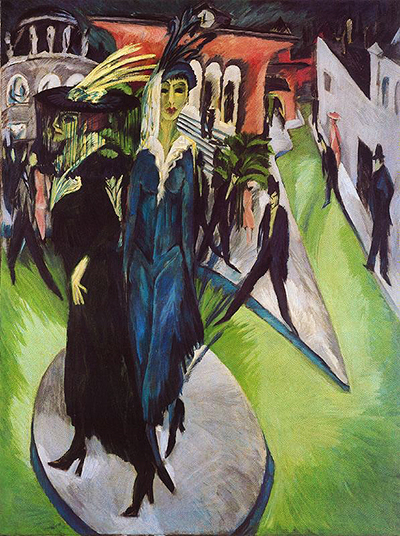Kirchner completed Potsdamer Platz in 1914, and it features two sisters who he became friends with during his time enjoying the hectic German nightlife.
Erna Schilling and her sister were dancers in a Berlin nightclub and at this time Kirchner was focusing his work on the city scene of Berlin and then Dresden. He found the whole environment chaotic and unhealthy, expressing this directly in the style of his paintings. That said, he was fond of these two sisters and would portray them elegantly and respectfully. It was normally the men in these scenes who were more negatively portrayed, either as predatory or even just in groups of homogenous, non-descript characters. It was clear where his loyalties lied and Erna particularly would remain a significant part of his life for some time.
In line with the expressionist approach of this artist, the angles and perspective of this composition are far from reality. The corners of roads jut out aggressively, and these exaggerated angles are seen throughout the work of Kirchner as well as several other artists with whom he spent considerable amounts of time during different periods of his career. There are elements of buildings in the background, enough detail to understand the overall structure of the painting, but without enough to be anywhere near realistic. There is also a set of steps leading to a terracotta-coloured building, perhaps signifying a key part of the square.
Both this painting plus also his Portrait of Erna Schilling can now be found at the National Gallery in Berlin, whose collection is spread over a number of venues, such is it's size. There is also an intention of allowing this national venue to be enjoyed by as many people as possible. They also hold work by the likes of Robert Delaunay and Pablo Picasso, with a key focus on work from the past two centuries. It remains one of the most significant art institutions in all of Germany and its collection ranks well against some of the major venues across the world, including in the US, UK and France. Some of the best alternatives include MoMA in New York plus the various Tate venues spread across London and in other parts of England.




